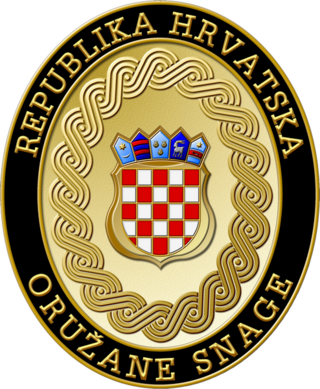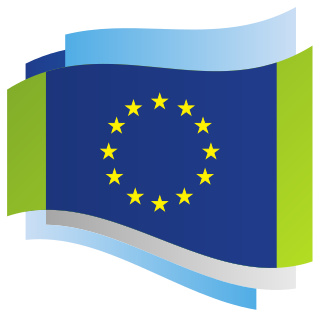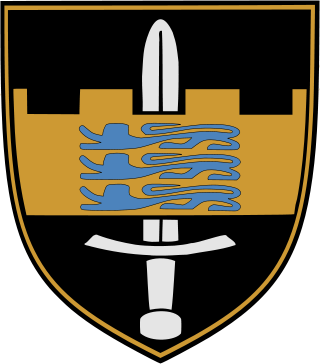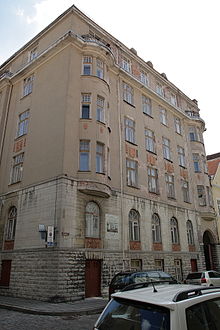
The Armed Forces of the Republic of Croatia are the military forces organized for the defense of the Republic of Croatia and its allies by military means and for other forms of use and use in accordance with the domestic and international law. The Croatian Armed Forces protect the sovereignty and independence of the Republic of Croatia and defend its territorial integrity.
Politics in Estonia takes place in a framework of a parliamentary representative democratic republic, whereby the Prime Minister of Estonia is the head of government, and of a multi-party system. Legislative power is vested in the Estonian parliament. Executive power is exercised by the government, which is led by the prime minister. The judiciary is independent of the executive and the legislature. Estonia is a member of the United Nations, the European Union, and NATO.

Defence Intelligence (DI) is an organisation within the United Kingdom intelligence community which focuses on gathering and analysing military intelligence. It differs from the UK's intelligence agencies in that it is an integral part of a government department – the Ministry of Defence (MoD) – rather than a stand-alone organisation. The organisation employs a mixture of civilian and military staff and is funded within the UK's defence budget. The organisation was formerly known as the Defence Intelligence Staff (DIS), but changed its name in 2009.

The European Defence Agency (EDA) is an agency of the European Union (EU) that promotes and facilitates integration between member states within the EU's Common Security and Defence Policy (CSDP). The EDA is headed by the EU High Representative for Foreign Affairs and Security Policy, European Commission’s Vice President (HR/VP), and reports to the Council. The EDA was established on 12 July 2004 and is based in Brussels, Belgium, along with a number of other CSDP bodies.

The United Kingdom's Strategic Command (StratCom), previously known as Joint Forces Command (JFC), manages allocated joint capabilities from the three armed services.

The Estonian Navy are the unified naval forces among the Estonian Defence Forces.

The Estonian Air Force is the aviation branch of the Estonian Defence Forces. The air force traces its history to 1918, and was re-established in its current form in 1991.

Leo Kunnas is an Estonian former military officer and a science fiction writer.

The Estonian Land Forces, unofficially referred to as the Estonian Army, is the name of the unified ground forces among the Estonian Defense Forces where it has an offensive military formation role. The Estonian Land Forces is currently the largest Estonian military branch, with an average size of approximately 6,000 soldiers, conscripts, and officers during peacetime.
DOTMLPF is an acronym for doctrine, organization, training, materiel, leadership and education, personnel, and facilities. It is used by the United States Department of Defense and was defined in the Joint Capabilities Integration Development System, or JCIDS Process as the framework to design what administrative changes and/or acquisition efforts would fill a capability need required to accomplish a mission. Because combatant commanders define requirements in consultation with the Office of the Secretary of Defense (OSD), they are able to consider gaps in the context of strategic direction for the total US military force and influence the direction of requirements earlier in the acquisition process, in particular, materiel.

The Estonian Defence Forces is the unified military force of the Republic of Estonia. The Estonian Defence Forces consists of the Estonian Land Forces, the Estonian Navy, the Estonian Air Force, and the paramilitary Estonian Defence League. The national defence policy aims to guarantee the preservation of the independence and sovereignty of the state and maintain the integrity of its land area, territorial waters, airspace, and constitutional order. Its main goals remain the development and maintenance of a credible capability to defend the nation's vital interests and of the defence forces in a way that ensures their interoperability with the armed forces of NATO and European Union member states in order to participate in the full range of missions for these military alliances.

The Estonian Special Operations Force is the command charged with overseeing the special operations units of the Estonian Defence Forces. Its primary objective is the development of capabilities for unconventional warfare. It is tasked with planning, preparing and executing special operations. These include special reconnaissance and surveillance, military support and direct action. ESTSOF is under direct command of the Commander of the Estonian Defence Forces.
The Estonian Foreign Intelligence Service is the foreign intelligence service of Estonia. The Foreign Intelligence Service coordinates with all Estonian intelligence functions, collects intelligence concerning foreign interests and activities, and transmits information to the President, Prime Minister, the General Staff of the Estonian Defence Forces, the Interior Minister, the Foreign Minister, and the Minister of Defence.
The National Security Strategy and Strategic Defence and Security Review 2015 was published by the British government during the second Cameron ministry on 23 November 2015 to outline the United Kingdom's defence strategy up to 2025. It identified key threats to the UK and the capabilities it required to address them.

Federated Mission Networking (FMN) is a significant initiative to help ensure the interoperability and operational effectiveness of the North Atlantic Treaty Organization. It is a key contribution to the Connected Forces Initiative, helping Allied and Partner forces to better communicate, train, and operate together. This includes the NATO Command Structure as well as the NATO Force Structure. The purpose of FMN is ultimately to support Command, Control, Communications, Computers, Intelligence, Surveillance and Reconnaissance (C4ISR) and decision-making in operations by enabling the rapid instantiation of mission networks. Including the NATO Command Structure, 39 nations have joined the FMN initiative as so-called "FMN Affiliates" and work together under the FMN Framework Process to coordinate the design, development, and delivery of operational and technical capabilities required to conduct net-centric operations. Each development increment is referred to as an "FMN Spiral." The respective requirements, architecture, standards, procedures, and technical instructions are documented in the so-called "FMN Spiral Specifications." FMN Spiral Specifications are based on well-known standards and best practices, hence supported by most off-the-shelf products and vendor neutral. TACOMS standards and profiles specify a common, technology- and topology independent network interoperability layer for federated mission networks. There is also a rolling 10-year FMN Spiral Specification Roadmap of the envisioned future capabilities. At the same time, the Coalition Interoperability Assurance and Validation (CIAV) process ensures that current interoperability issues are being identified and fed back into FMN capability development.

The European Defence Fund (EDF) is a component of the European Union's (EU) Common Security and Defence Policy (CSDP) which aims to coordinate and increase national investment in defence research and improve interoperability between national armed forces. It was proposed in 2016 by Commission President Jean-Claude Juncker and established in 2017. The fund has two stands; Research and Development & Acquisition. In July 2018, the European Commission announced that the EDF budget for 2021-2027 would be €13 billion. This sum was later revised by the European Commission as part of the new EU budget proposed on May 27, 2020, as a result of the COVID-19 pandemic, according to which the EDF will be allocated €8 billion over this budget period.

The Kaitseväe orkester, known in Anglophone countries as the Band of the Estonian Defence Forces, is the official military band service of the Estonian Defence Forces. The main task of the band is to play music at all national and military ceremonies. The band's repertoire includes mostly classical and marching music. It is currently made up of 40 musicians. From 1996 to 2019, the conductor of the band was Lieutenant Colonel Peeter Saan. Each year, the band takes part in about 220 concerts, festivals, and ceremonial parades of the Defence Forces. It has also performed at venues abroad in countries like Lithuania, France and Germany. Traditionally, the band holds Autumn and Spring concerts in the Estonia Concert Hall.

Riho Ühtegi is an Estonian major general. He has been the Commander of the Estonian Special Operations Force. Since 2019, he is the commander of the Estonian Defence League.

This article outlines the present structure of the European Union's Common Security and Defence Policy (CSDP), a part of the Common Foreign and Security Policy (CFSP) based on articles 42–46 of the Treaty on European Union (TEU). Article 42.2 of TEU states that the CSDP includes the 'progressive framing' of a common Union defence policy, and will lead to a common defence, when the European Council of national heads of state or government, acting unanimously, so decides.

















